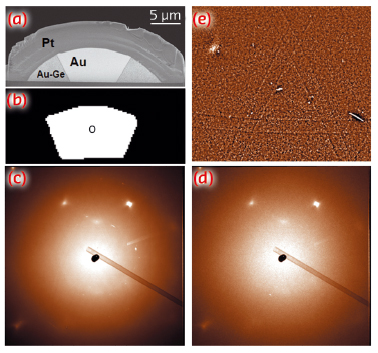- Home
- Users & Science
- Scientific Documentation
- ESRF Highlights
- ESRF Highlights 2014
- Soft condensed matter
- Formation of curved micrometre-sized single crystals
Formation of curved micrometre-sized single crystals
One remarkable outcome of biogenic crystal growth is the formation of unfaceted sculptured single crystals with rounded shapes and even crystals that are highly porous. This is in contrast to crystal growth by classical methods, which produce facets dictated by the atomic structure and minimisation of the surface energy, leading to specific low surface energy facets. Drawing inspiration from nature in regard to the growth of unfaceted single crystals, we demonstrate that single crystals of gold can indeed also exhibit curved surfaces. This occurs during crystal growth without the need for any top-down fabrication steps. These single crystals grow from a confined volume of a droplet of a eutectic composition melt, which forms via the dewetting of nanometric thin films. We can control crystal curvature by controlling the process environment, including several parameters, such as the contact angle and the curvature of the drops by changing the surface tension of the liquid drop during crystal growth.
By controlling the shape and size of the droplet, we aim to tailor the shape and size of the single crystal growing within it. The mechanism we employed for the formation of such droplets was the dewetting phenomenon in nanometric thin films. To induce dewetting into liquid droplets, a thin film needs to be brought to its melting point. A eutectic system such as gold-germanium seemed an ideal choice for this purpose owing to the relatively low temperature at which the liquid state can be achieved (TE = 361°C). If a eutectic film of Au-Ge is deposited on a non-wetting surface such as SiO2, it dewets on reaching the eutectic temperature (Figure 47a) and produces liquid droplets within which Au single crystals form (Figure 47b).
 |
|
Fig. 47: HRSEM micrographs of Au-Ge droplets after dewetting. a) A large area view of the dewetted surface revealing several droplets. b) A side view of a curved gold single crystal within a micro droplet. c) A droplet cross-section obtained by FIB reveals facets inside the droplet but a curved shape on the surface. |
Energy dispersive spectroscopic (EDS) examination of the single crystals proved that they are gold. To confirm that these crystals are indeed single throughout their entire volume, we prepared cross-sections of these droplets using a focused ion beam (FIB) (Figure 47c). This enabled us to observe that each crystal was faceted inside the droplet and possessed a curved surface confined by the droplet’s surface. Moreover, the 3D curvature of these single crystals was identical to that of the droplets.
To obtain a crystallographic proof that these crystals were single, we used sub-micrometre scanning synchrotron diffractometry at beamline ID13, on a FIB-sectioned crystal of gold (Figure 48a). At each point of the scanned area (1793 scanning points) the same thermal diffuse scattering pattern of a bulk single crystal was observed (Figure 48b). We also verified this by averaging all the 1793 diffraction images from the different locations of the crystal and found that this integrated image remained identical to any one of the individual diffraction images (Figure 48c-d). Furthermore, a single crystal Kossel line pattern emerging from Bragg-type diffraction of gold X-ray fluorescence radiation generated by the primary beam was clearly visible in the averaged pattern (Figure 48e).
 |
|
Fig. 48: a) Cross-section of a FIB-prepared droplet that was used for the high-resolution X-ray scan. b) A binary mask derived from mapping of average intensity by simple thresholding in each diffraction pattern, representing the X-ray fluorescence background of the scanned gold crystal. c) Average diffraction pattern of all corrected images of the area in (b) (1793 diffractions). Nano-beam Kossel lines can be observed due to the Au-Fluorescence. d) Corrected (spatial distortion and flat field) diffraction pattern of scan point which was taken from the centre of the single crystal, marked with a circle on (b), for reference. e) High pass filtered version of the average image enhancing the Kossel-lines. |
The energetic mechanism that permits the formation of such curved single crystals is that the free energy of a liquid/solid gold interface is yet lower than the free energy of vacuum/solid gold interface. That is why the gold crystals favour the energetic curved surfaces within the droplet, rather than breaking out of the droplet and exposing their facets.
In conclusion, using a relatively simple method such as the dewetting from thin films, and exploiting thermodynamic process such as crystallisation from an eutectic melt, we have demonstrated a method for creating a single curved crystal that grows in the confined space of its own melt, replicating the 3D shape of the droplet.
Principal publication and authors
M. Koifman Khristosov (a), L. Kabalah-Amitai (a), M. Burghammer (b,c), A. Katsman (a) and B. Pokroy (a), ACS Nano, 8, 4747–4753 (2014).
(a) Technion Israel Institute of Technology (Israel)
(b) ESRF
(c) Ghent University (Belgium)



